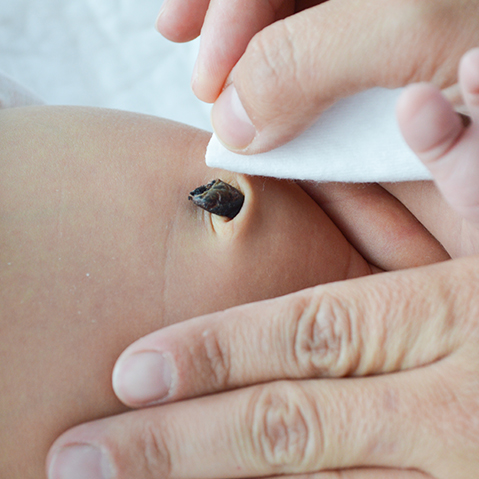
Umbilical Cord Care
Cord Care
It’s called an umbilical stump!
While baby is developing in your womb, you are directly connected by the umbilicus or umbilical cord – a lifeline of nutrition between mother and child. Shortly after your baby is born, your midwife will clamp and cut this umbilical cord. It doesn’t hurt – neither of you will feel anything, as there are no nerves in the cord.
What’s left behind, where the cord joins your newborn's tummy, is a 2cm to 3cm-long stump. It will dry out and fall off by itself between five and 15 days after the birth, but until then you'll need to keep it clean and free from infection. You’ll see it shrivel and change colour, from yellowish-green to brown or black, then it should then drop off by itself. Be sure to let the stump come away naturally. Don’t pull on it.
How do I care for my baby's stump?
You'll need to keep your baby’s umbilical stump clean and dry to prevent it from becoming infected. Always wash your hands before and after you change baby’s nappy, wash or handle the stump. Dress your baby in loose clothing, to allow air to get to the cord, and fold down the front of the nappy to expose the stump. Some newborn nappies have a cut-out at the front especially so that the cord is not covered.You can keep the stump clean by giving your baby a bath or topping and tailing him with a warm, moist flannel or sponge. You can use plain water, or a mild, liquid baby cleanser that you've added to his bathwater. You don’t need to use an antiseptic on the stump. Just keeping it clean will be enough. Using antiseptics can mean the stump takes longer to fall off.
Getting your baby's stump wet won't slow up healing or encourage infection, as long as you dry the cord afterwards by gently patting the stump with a soft, clean towel or cloth. Keep your baby warm but let the stump dry fully before putting on a nappy.
If your baby is premature or spends time in special care, the advice is still to keep the stump clean and dry. However, bear in mind that your baby may not be able to have a bath for a while because he's more vulnerable than a healthy, full-term baby. Staff on the neonatal unit will give you advice on caring for your baby and the best way to keep him clean.
How long will it take for the belly button to heal?
After the stump falls off there will be a small wound, which may take between seven and 10 days to heal completely. You may see a little blood on your baby's nappy. This is quite normal.
The healed wound becomes your baby's belly button.
How will I know if my baby's stump is infected?
It’s normal for your baby's stump to look a bit mucky as it’s healing, or even to have pus at the base. This doesn’t mean that it’s infected.However, if your baby has the following symptoms, then the stump may be infected:
- The navel and the surrounding area is swollen or red.
- The stump is swollen, smelly or weepy
- Baby has a fever, is lethargic, showing a lack of interest in feeding or appears generally unwell.
- There is bleeding or discharge from your baby’s belly button.
If your baby has any of these signs call your midwife or doctor.
What should I do if my baby’s stump doesn’t heal?
Very rarely your baby's cord will take longer than 10 days to heal. Sometimes bits of lumpy flesh may appear in the wound. This is nothing to be concerned about, and these lumps will soon disappear.However, if the flesh within the stump looks clean but is unhealed and sore ask your midwife or health visitor to check the stump for you. Your baby may need to see your GP, who will decide if the stump should be sealed by a nurse.
Sealing is called cauterisation. Although this may sound scary, it's a simple procedure. Your nurse will use a little stick made of silver nitrate to do the job. It's a very common procedure and it won't hurt your baby at all.

